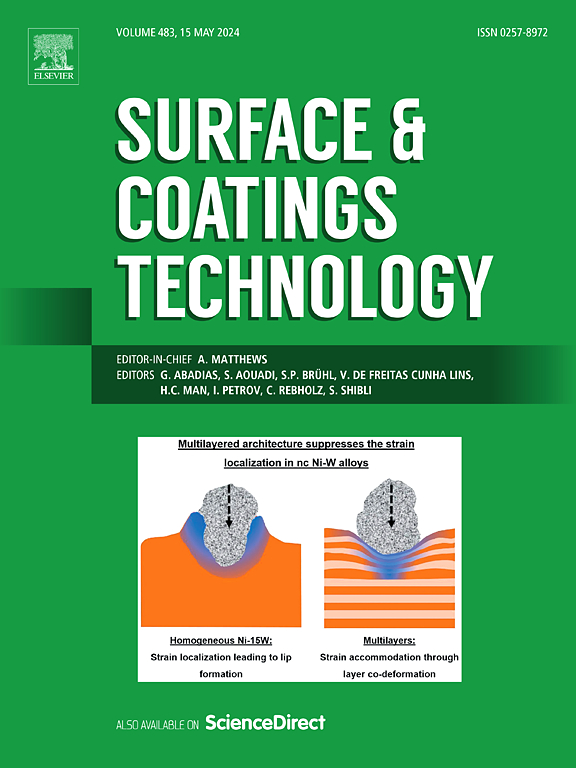A comparative study on microstructure evolution of metamorphic layers induced by grinding and laser quenching in hardened AISI 52100 steel
IF 5.3
2区 材料科学
Q1 MATERIALS SCIENCE, COATINGS & FILMS
引用次数: 0
Abstract
This study presents a comparative analysis of the similarities and differences in the microstructure characteristics between ground and laser-quenched metamorphic layers on the AISI 52100 steel, revealing the respective impacts of thermal and mechanical effects on the microstructure evolution of metamorphic layers (i.e. white layer (WL) and dark layer (DL)). The results show that both thermal and mechanical effects result in grain refinement within WL. However, the increase in the proportions of sub-grain boundaries (SGBs) and low-angle grain boundaries (LAGBs) is caused by the mechanical effect, irrespective of the thermal effect. Furthermore, in addition to the mechanical effect, the thermal effect is also responsible for increased dislocation density within WL. The thermal effect causes the partial dissolution of carbides, while the mechanical effect results in the deformation and refinement of carbides in WL. In the DL, the thermal effect coarsens grains through grain boundary migration, accompanied by forming carbides due to the precipitation of C atoms. The dislocation density and the proportions of SGBs are reduced. However, the influence of the mechanical effect on the microstructure alterations of the DL is negligible. The hardness of the ground WL is increased by approximately 49.1 %, and such an increase is attributed to three factors: solid solution strengthening due to thermal effect, dislocation strengthening due to mechanical effect, and grain boundary strengthening due to thermal and mechanical effects. The thermal effect results in the formation of over-tempered martensite in the subsurface layer, reducing the hardness of ground DL by approximately 35.4 %. The results provide theoretical guidance for controlling the generation or utilization of metamorphic layers on AISI 52100 steel.

本研究对比分析了 AISI 52100 钢上研磨变质层和激光淬火变质层微观结构特征的异同,揭示了热效应和机械效应对变质层(即白层 (WL) 和暗层 (DL))微观结构演变的各自影响。结果表明,热效应和机械效应都会导致 WL 内的晶粒细化。然而,亚晶界(SGB)和低角度晶界(LAGB)比例的增加是由机械效应引起的,与热效应无关。此外,除机械效应外,热效应也是 WL 内位错密度增加的原因。热效应导致碳化物部分溶解,而机械效应则导致 WL 中碳化物的变形和细化。在 DL 中,热效应通过晶界迁移使晶粒粗化,同时由于 C 原子的析出形成碳化物。位错密度和 SGB 的比例降低。然而,机械效应对 DL 微观结构变化的影响可以忽略不计。研磨 WL 的硬度提高了约 49.1%,这种提高归因于三个因素:热效应导致的固溶体强化、机械效应导致的位错强化以及热效应和机械效应导致的晶界强化。热效应导致在次表层形成过回火马氏体,使地层 DL 的硬度降低了约 35.4%。研究结果为控制 AISI 52100 钢变质层的产生或利用提供了理论指导。
本文章由计算机程序翻译,如有差异,请以英文原文为准。
求助全文
约1分钟内获得全文
求助全文
来源期刊

Surface & Coatings Technology
工程技术-材料科学:膜
CiteScore
10.00
自引率
11.10%
发文量
921
审稿时长
19 days
期刊介绍:
Surface and Coatings Technology is an international archival journal publishing scientific papers on significant developments in surface and interface engineering to modify and improve the surface properties of materials for protection in demanding contact conditions or aggressive environments, or for enhanced functional performance. Contributions range from original scientific articles concerned with fundamental and applied aspects of research or direct applications of metallic, inorganic, organic and composite coatings, to invited reviews of current technology in specific areas. Papers submitted to this journal are expected to be in line with the following aspects in processes, and properties/performance:
A. Processes: Physical and chemical vapour deposition techniques, thermal and plasma spraying, surface modification by directed energy techniques such as ion, electron and laser beams, thermo-chemical treatment, wet chemical and electrochemical processes such as plating, sol-gel coating, anodization, plasma electrolytic oxidation, etc., but excluding painting.
B. Properties/performance: friction performance, wear resistance (e.g., abrasion, erosion, fretting, etc), corrosion and oxidation resistance, thermal protection, diffusion resistance, hydrophilicity/hydrophobicity, and properties relevant to smart materials behaviour and enhanced multifunctional performance for environmental, energy and medical applications, but excluding device aspects.
 求助内容:
求助内容: 应助结果提醒方式:
应助结果提醒方式:


